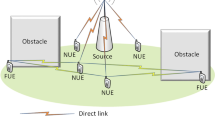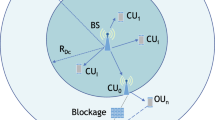Abstract
The orthogonal space-time block code (OSTBC) and cooperative relaying schemes are the two major spatial diversity techniques to achieve high link reliability in any wireless communication system. Typically, the OSTBC based cooperative amplify-and-forward relaying system achieves optimal diversity gain with simple linear decoding by assuming that the channels remain quasi-static during the length of the Alamouti code-word symbol periods. However, due to time selective fading or relay node’s mobility, the quasi-static assumptions does not hold good and causes severe error floor in the system. In this paper, at first, we have investigated various conventional signal detection methods to improve the system performance which include Alamouti and quasi-ML detection (QMLD) methods. Then, we derive the exact closed-form signal-to-interference-plus-noise ratio expression for the Alamouti method and signal-to-noise ratio for the QMLD method. Based on this performance analysis, we propose a decision feedback detection (DFD) which is a hybrid of Alamouti and QMLD methods. The simulation results show that the proposed DFD method significantly outperforms the conventional QMLD method under high mobility channel environment.







Similar content being viewed by others
References
Foschini, G. J. (2002). Layered space-time architecture for wireless communication in a fading environment when using multi-element antennas. Bell Labs Technical Journal, 1(2), 41–59.
Bolckei, Gesbert, & Paulraj, (2002). On the capacity of OFDM-based spatial multiplexing systems. IEEE Transactions on Communications, 50(2), 225–234.
Paulraj, A. J., Gore, D. A., Nabar, R. U., & Bolcskei, H. (2004). An overview of MIMO communications—a key to gigabit wireless. Proceedings of the IEEE, 92(2), 198–218.
Zhang, W., Xia, X.-G., & Letaief, K. B. (2007). Space-time/frequency coding for MIMO-OFDM in next generation broadband wireless systems. IEEE Wireless Communications, 14(3), 32–43.
Sendonaris, A., Erkip, E., & Aazhang, B. (2003). User cooperation diversity. Part I: System description. IEEE transactions on communications, 51(11), 1927–1938.
Sendonaris, A., Erkip, E., & Aazhang, B. (2003). User cooperation diversity. Part ii: Implementation aspects and performance analysis. IEEE Transactions on communications, 51(11), 1939–1948.
Laneman, J. N., Tse, D. N. C., & Wornell, G. W. (2004). Cooperative diversity in wireless networks: Efficient protocols and outage behavior. IEEE Transactions on Information theory, 50(12), 3062–3080.
Dohler, M., Hussain, M., Desai, A., & Aghvami, H. (2004). Performance of distributed space-time block codes. In Vehicular technology conference, 2004. VTC 2004-Spring. 2004 IEEE 59th (Vol. 2, pp. 742–746). IEEE.
Jing, Y., & Hassibi, B. (2006). Distributed space-time coding in wireless relay networks. IEEE Transactions on Wireless Communications, 5(12), 3524–3536.
Alamouti, S. M. (1998). A simple transmit diversity technique for wireless communications. IEEE Journal on Selected Areas in Communications, 16(8), 1451–1458.
Jing, Y., & Jafarkhani, H. (2007). Using orthogonal and quasi-orthogonal designs in wireless relay networks. IEEE Transactions on Information Theory, 53(11), 4106–4118.
Lee, I.-H., & Kim, D. (2008). End-to-end ber analysis for dual-hop OSTBC transmissions over Rayleigh fading channels. IEEE Transactions on Communications, 56(3), 347–351.
Chen, S., Wang, W., Zhang, X., & Sun, Z. (2010). Performance analysis of ostbc transmission in amplify-and-forward cooperative relay networks. IEEE Transactions on Vehicular Technology, 59(1), 105–113.
Li, G., Blostein, S. D., & Qin, J. (2010). Performance analysis of two-hop OSTBC transmission over Rayleigh fading channels. EURASIP Journal on Wireless Communications and Networking, 2010(1), 649541.
Duong, T. Q., Alexandropoulos, G. C., Zepernick, H.-J., & Tsiftsis, T. A. (2011). Orthogonal space-time block codes with CSI-assisted amplify-and-forward relaying in correlated Nakagami-\(m\) fading channels. IEEE Transactions on Vehicular Technology, 60(3), 882–889.
Li, G., Blostein, S. D., & Feng, J. (2013). Performance analysis of OSTBC transmission in multiuser multiantenna relay networks. IEEE Transactions on Vehicular Technology, 62(1), 421–427.
Jayasinghe, L. K. S., Rajatheva, N., Dharmawansa, P., & Latva-Aho, M. (2013). Noncoherent amplify-and-forward mimo relaying with ostbc over rayleigh-rician fading channels. IEEE Transactions on Vehicular Technology, 62(4), 1610–1622.
Khattabi, Y. M., & Matalgah, M. M. (2016). Performance analysis of multiple-relay af cooperative systems over rayleigh time-selective fading channels with imperfect channel estimation. IEEE Transactions on Vehicular Technology, 65(1), 427–434.
Khattabi, Y.., & Matalgah, M. M. (2016). Ostbc transmission over cooperative diversity systems under nodes mobility impact. In Wireless communications and networking conference (WCNC) (pp. 1–6). IEEE.
Khattabi, Y., & Matalgah, M. M. (2016). Improved error performance zfstd for high mobility relay-based cooperative systems. Electronics Letters, 52(4), 323–325.
Khattabi, Y., & Matalgah, M. M. (2016). A low-complexity sub-optimal decoder for ostbc-based mobile cooperative systems. In Wireless communications and networking conference (WCNC) (pp. 1–6). IEEE.
Tran, T. A., & Sesay, A. B. (2004). A generalized linear quasi-ml decoder of ostbcs for wireless communications over time-selective fading channels. IEEE Transactions on Wireless Communications, 3(3), 855–864.
Proakis, J. G. (2001). Digital communication. Hoboken: Wiley Online Library.
Reed, I. (1962). On a moment theorem for complex gaussian processes. IRE Transactions on Information Theory, 8(3), 194–195.
Zheng, Y. R., & Xiao, C. (2003). Simulation models with correct statistical properties for rayleigh fading channels. IEEE Transactions on communications, 51(6), 920–928.
Author information
Authors and Affiliations
Corresponding author
Additional information
Publisher's Note
Springer Nature remains neutral with regard to jurisdictional claims in published maps and institutional affiliations.
Rights and permissions
About this article
Cite this article
Patra, J.P., Singh, P. On Signal Detection for OSTBC-Based Amplify-and-Forward Cooperative Relaying System Over Time Selective Channel. Wireless Pers Commun 101, 2209–2226 (2018). https://doi.org/10.1007/s11277-018-5812-4
Published:
Issue Date:
DOI: https://doi.org/10.1007/s11277-018-5812-4




